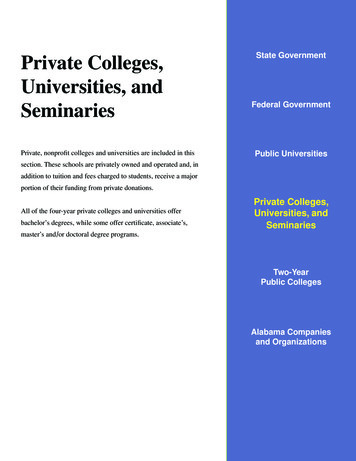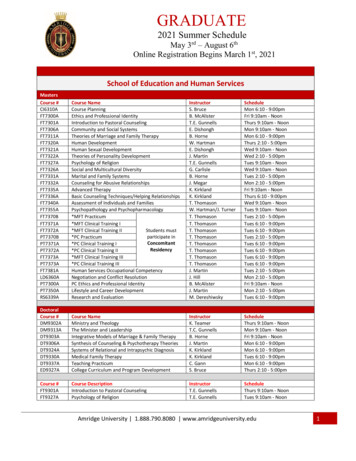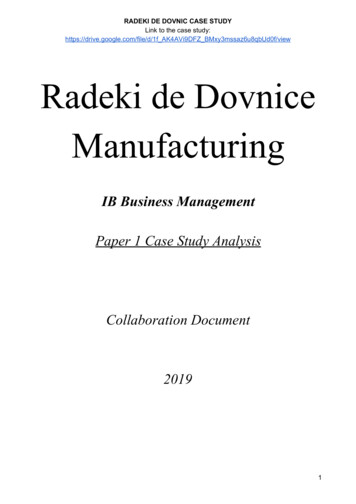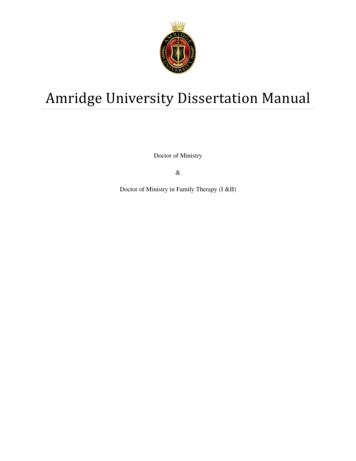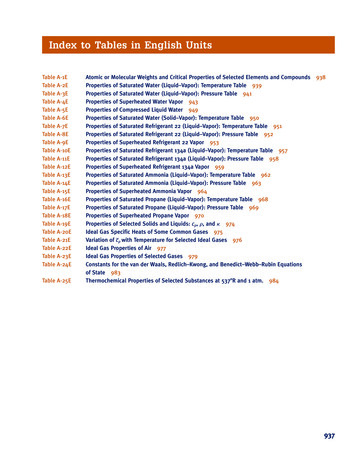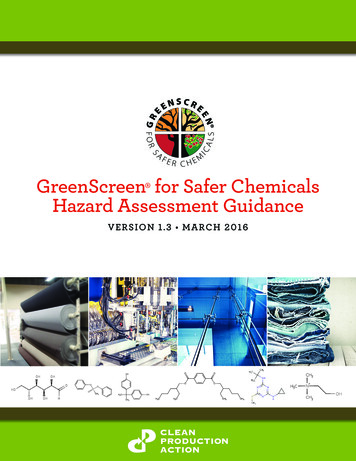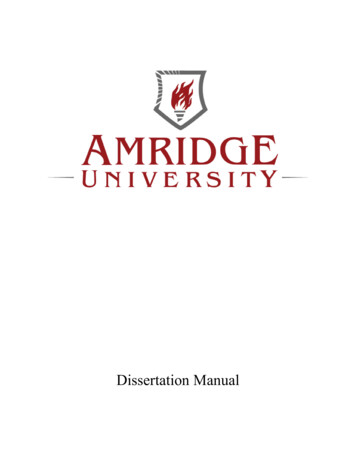
Transcription
Dissertation Manual
2TABLE OF CONTENTSPurpose of the Manual . 3Introduction . 3Beginning the Dissertation. 4Dissertation Milestones Overview . 4Dissertation Modules . 5Dissertation Committees . 5Style Manuals . 5Dissertation Guidelines . 6Topic Selection . 7Milestone #1 – Dissertation Topic Paper . 8Milestone # #2 – The Dissertation Proposal . 8Milestone #3 – IRB Approval. 9Milestone #4 – Final Dissertation Manuscript . 10Milestone #5 – The Oral Defense. 10Susbmitting Dissertations to the Library . 10References . 12
3PURPOSE OF THE MANUALPublished words become a permanent part of the public domain. Long after a student has graduated, hisor her written work continues to represent his scholarship. Therefore, what one writes becomes anoriginal contribution to the literature in one’s field of study. A student must not plagiarize or otherwisemisuse what others have written. Amridge University puts great value on research and well-writtendissertations. Like any other major university, Amridge insists that all written materials emanating fromthe University follow a uniform style.This manual provides the student/researcher and the Dissertation Committee a common basis from whichto proceed in researching and writing the dissertation. One’s dissertation should demonstrate his or herknowledge of the field, ability to conduct advanced research, organizational skills, and competence inboth oral and written presentation. The dissertation should be used as a tool to ascertain and dispense truthindependent of one’s desired results.The contents of this manual are selected primarily from policies and procedures in the academic catalogand other sources. Efforts will be made to keep this manual up-to-date with University policies andrequirements. However, the user of this manual should be aware that the current Amridge UniversityAcademic Catalog is the most accurate source of University policy and, should policies in the academiccatalog differ from this manual, the policies in the catalog will take priority.In the process of writing a dissertation, the researcher may use many resources such as people withknowledge of the subject and aids such as computer software, but the student ultimately bears theresponsibility to defend his or her work and own it as intellectual property. A good dissertation enablesthe student to obtain a terminal degree -- an accomplishment which relatively few people can claim.INTRODUCTIONThe information in this manual applies to all Amridge University doctoral degree programs. Students andfaculty members should be familiar with the contents of this manual, as it contains key informationregarding the expectations and components of the dissertation.The doctoral dissertation at Amridge University is a formal, written document that is accepted for partialfulfillment of a doctoral degree program. The doctoral dissertation demonstrates the student’s ability to:1.2.3.4.5.Analyze and synthesize the pertinent literature on a subject;Identify, select and verbalize a valid, researchable problem;Design and implement a scientific investigation;Analyze the results of the investigation and draw supported conclusions; andDevelop a written report of the study that meets standards of the profession and present practicalinformation to professionals in the field.It is important to note that there are differences in and variations between Doctor of Ministry (DMin),Doctor of Education (EdD), and Doctor of Philosophy (PhD) dissertations. The PhD dissertation focuseson making a new contribution to the body of knowledge in one’s field. That is, PhD dissertation mustmake a scholarly contribution to both the research and theory (e.g., generating a new theory or testing anexisting theory).
4DMin and EdD dissertations are applied dissertations. That is, they are practice-based and focus onmaking practical contributions to documented problems and issues for which there is not already anacceptable solution. An applied dissertation does not necessarily require generalizable results beyond thestudy site; however, it must address a problem that is relevant and exists outside of the study site.BEGINNING THE DISSERTATIONThe student must pass his or her Qualifying Examination and achieve “Candidacy Status” prior toenrolling in the first Dissertation Module. Candidacy Status marks a major milestone in one’s doctoraljourney and represents the transition from student to independent researcher. Before beginning thedissertation, the student should have a general understanding of the dissertation purpose, standards, andrequired procedures. The student must be eligible to begin the dissertation and must have a dissertationcommittee appointed. The student must develop the dissertation through a series of dissertation modulecourses and must receive approval from the Institutional Review Board prior to beginning data collection.DISSERTATION MILESTONES OVERVIEWThe Milestone approach provides the student with a structure to plan and complete the dissertation whileallowing room for individuality in the process. Upon completion of Milestone #1: Topic Paper, theDissertation Modules are taken continually and sequentially until all dissertation milestones have beencompleted.Milestone #1: Topic Paper. The student develops a paper and makes a presentation during theQualifying Examination course. A main objective is to ensure students obtain feedback about thefeasibility and worthiness of their topic.Milestone #2: Dissertation Proposal. Contains Dissertation Committee and Academic LeadershipTeam approved Chapters 1 – 3 of the dissertation. Note: achieving this milestone will take the longest(approximately 6 – 8 months on average).Milestone #3: Amridge University IRB Approval. With Chapter 3 complete and approved by theDissertation Committee and Academic Leadership Team, this will flow smoothly for most candidates.Once IRB approval is obtained, data collection can commence immediately.Milestone #4: Final Dissertation Manuscript. Once all of the data are collected, the major elementsmissing are Chapters 4 and 5. The Final Manuscript includes the findings from the analysis,recommendations for future research, and practical applications.Milestone #5: Oral Defense. Student presentation that highlights the key elements of the study.Questions from committee members and others.
5DISSERTATION MODULESThe dissertation is to be completed through a sequence of Dissertation Module courses. Each degreeprogram has a minimum number of Dissertation Module courses, and the maximum number ofDissertation Module courses for all doctoral degree programs is 12. Dissertation Module courses aretaken continually and sequentially until all Dissertation Milestones have been completed (i.e. DissertationModule 1, Dissertation Module 2, etc.). The sequence of Milestones is mandatory, but the number ofDissertation Modules required to complete all of the Dissertation Milestones will vary. After beginningthe dissertation the student must enroll in a Dissertation Module course each semester until completion ofthe dissertation.DISSERTATION COMMITTEESThe dissertation is developed by the student with the advice, guidance and approval of the DissertationCommittee. The Dissertation Committee is composed of the student, a chairperson, one or more readers,and the dissertation secretary. The Dissertation Committee is assigned during the semester in which thestudent is enrolled in the Qualifying Examination. The student, in consultation with the QualifyingExamination instructor, may request that specific individuals be appointed to his or her DissertationCommittee.Student - The student is responsible for his or her dissertation. This includes registering for the correctDissertation Module courses, selecting the dissertation topic, conducting the literature review,designing the research plan, obtaining necessary approvals, executing the research plan, writing thedissertation, obtaining approval for each module, defending the dissertation, and fulfilling alldissertation completion processes.Chairperson - The dissertation chairperson is the leader and coordinator of the dissertationcommittee. The dissertation chairperson provides advice and reactions to the student’s ideas andmaterials. The dissertation chairperson communicates to the students the directions and decisions ofthe committee. The dissertation chairperson considers both the technical content and the written formof the student’s presentations. The dissertation chairperson decides when to bring in the dissertationreader for suggestions and reactions during the planning and development stages.Reader - The dissertation reader provides assessment and advice regarding subject matter contentwhen requested by the dissertation chairperson. The reader sends all communication and feedbackback through the ChairpersonSecretary - The dissertation secretary is responsible for assessing the quality of the written productbased on standards of grammar, sentence structure, and the appropriate writing style manual. Thesecretary sends all communication and feedback back through the chairperson.STYLE MANUALSIt is the student’s responsibility to become familiar with the appropriate writing style manual and ensurethat anyone assisting in the typing of the document follows the rules of the manual. The style manuals
6also include directions for the reporting of numbers, construction of tables and figures, structure ofheadings, use of terms, preferred language, and the expression of ideas or writing style suggestions.Writing for research or publication demands a new level of dedication and compliance to rules, and, inorder to be acceptable by publishers of professional literature, the student must demonstrate this ability.The committee must be able to focus on the substantive content of the dissertation without spendingvaluable time looking for infractions of these rules. Students enrolled in the College of Business and Leadership are required to use the writingguidelines provided in the latest edition of the Publication Manual of the American PsychologicalAssociation (APA Manual).Students enrolled in the School of Education and Human Services are required to use the writingguidelines provided in the latest edition of the Publication Manual of the American PsychologicalAssociation (APA Manual).Students enrolled in the Turner School of Theology are required to use the writing guidelinesprovided in the latest edition of the Chicago Manual of Style (CMS Manual) and/or Society ofBiblical Literature Handbook of Style (SBLHS); however, APA is acceptable in some cases (e.g.Doctor of Ministry courses and dissertations).Allowable alternatives/exceptions to the University approved style manuals: A student may choose whether to use one or two spaces after a period, as long as consistency ismaintained.The possessive of Jesus may be done as Jesus’ or Jesus’s, according to the student’s preference.Pronouns for religious figures, including God and Jesus as deity (e.g. he, him, and his), may beeither upper case or lower case, as long as consistency is maintained. In quotations of works byother authors, the integrity of sources must be maintained by preserving either upper or lowercase pronouns for deity as found in the original sources.DISSERTATION GUIDELINESStudents conducting research involving human subjects are strongly encouraged to follow the traditionaldissertation format, which consists of five chapters. This format is most common; however, variationsexist. The candidates should consult with his or her Dissertation Committee to determine the mostappropriate format with consideration given to the chosen approach.Templates are provided in the Dissertation Module courses for students to consider along with advicefrom their committees. General, suggested guidelines for page numbers are included below. Chapters mayvary slightly by name and/or page length as a result of the chosen research method and design. Forexample, if a student puts most of the research results and findings in an appendix, Chapter 4 might bequite short. If the data is quite extensive and if it is all reported in Chapter 4 rather than an appendix,Chapter 4 could exceed 30 pages. Note: students pursing the PhD in Biblical Studies who are notconducting research involving human subjects should follow a modified version of the traditionaldissertation format available in the dissertation module courses.The quality of the work is more important than the actual length of the dissertation or the individualchapters. Students should listen to the advice of the chairperson and the other committee members as theyjudge the unique topic and the research needed to address the research problem and questions in theproper manner.
75 Chapter Dissertation GuidelinesChapter 1 - Introduction (12 -20 pages)The introductory chapter generally includes the following key sections: Need for the Study, Statementof the Problem, Purpose of the Study, Delimitations, and Definitions of Key Terms.Chapter 2 - Review of Literature (30 - 50 pages)In the Review of Literature, the candidate should summarize and synthesize the peer-reviewedliterature relevant to the topic area of the dissertation. Findings from existing studies should not bemerely reported; they should be compared and contrasted when appropriate.Chapter 3 - Research Method (15 - 20 pages)Discuss the appropriateness of the research method as it relates to the problem statement, and presentthe research design chosen for the study. Provide enough details so that the study could be replicated.Chapter 4 - Reporting of Data (15 - 30 pages)Present and evaluate the findings in light of the research questions.Chapter 5 - Conclusions and Recommendations (15 - 30 pages)Draw conclusions based on the findings presented in Chapter 4. Discuss practical implicationsresulting from the conclusions.TOPIC SELECTIONSelecting a topic for researching and writing a dissertation is one of the most important decisions one canmake in a doctoral program. Do not rush and make a quick, hasty decision on a dissertation topic. Rather,make a cautious, careful, deliberate decision in the choosing of a topic, and the rest of your work inresearch, gathering data, analysis, writing, and defense will go much smoother and be more pleasant.There are many ways you can go about selecting a topic (Neuman, 2006). Begin by exploring ideas fromyour personal professional experience and examining current cultural trends that affect your field. Thecurrent state of knowledge in your field of study will yield many topics that are valid for research. Inreviewing your vocational specialty, consider the problems people often struggle with. Also consider thevalues to which you are committed – religiously, socially, ethically, and politically – and explore how atopic might be embedded in these aspects. You should also seek advice from professors and scholars forareas of study that need to be explored further (Lei, 2009) and explore recommendations for furtherresearch in recently published peer-reviewed journals. As you continue to narrow your topic, consider thefollowing questions:1. Is it WORTHY? Choose a topic that merits the time and effort of dissertation research. It couldtake two or three years to complete your project, so you need to choose a topic worthy of thatcommitment. By the way, it is a myth that you must pick a topic that you are passionate about orone to which you have a prior commitment (Ségol, 2014).2. Is it FEASIBLE? Pick a topic that is manageable. Be realistic. Consider the resources that will beneeded, the participants that will potentially be involved, and the time that will be required.3. Is it RELEVANT? Select a topic that is timely; it should matter to and make a difference in yourfield now and in the future. Strive to make your dissertation of publishable quality, and think of itas a way to make a positive impact on others and advance your career. Those things are morelikely to occur when your topic is relevant.
8Once you have found a topic that you think is perfect for you, your academic goals, and your vocationalgoals, further groundwork is still needed. Search the dissertation index for other dissertations on this topicto see what others have written. Remember, your dissertation needs to be original work. If otherdissertations exist on a similar topic, read their abstracts to see if they are cast in a different setting or ifthey tackle a somewhat different problem. You want to make sure that your dissertation proposal will beunique. You should also do a bibliographical survey of books and journal articles to ensure there issufficient literature available for your literature review. Finally, confer with the instructor who has themost expertise within your topic area, since that instructor would be the most likely person to be thechairperson for your dissertation committee. Get advice from him or her on the suitability of your topic.Find an advisor who is knowledgeable about your dissertation topic and is able to help you analyze it forpotential issues, problems or dangers. Try to choose an advisor with whom you think you will have agood working relationship (McKinley, Grant, Middleton, Irwin, & Williams, 2009).MILESTONE #1 – DISSERTATION TOPIC PAPERThe Topic Paper is developed over the course of the first 12 weeks of the semester under the supervisionof the faculty member assigned to teach the Qualifying Exam course with input from the student’sdissertation chairperson. Then, the student makes a live presentation online near the end of the semester.The components required in the Topic Paper will evolve into the major elements required for Milestone#2 – The Dissertation Proposal. The Topic Paper must contain the following sections, and headingsshould be properly formatted and use these exact terms (Exception: this does not necessarily apply tostudents enrolled in the PhD in Biblical Studies degree program). IntroductionProblem StatementPurpose StatementResearch QuestionsDefinition of Key TermsLiterature Review (will later evolve into Chapter 2)Research Method and Design (will later evolve into Chapter 3)ConclusionMILESTONE #2 – THE DISSERTATION PROPOSALThe Dissertation Proposal provides the foundation for the research plan and serves as the candidate’sroadmap to completion of the dissertation. Achieving this milestone takes the longest (approximately 6 to8 months on average). The Dissertation Proposal contains Chapters 1, 2, and 3 of the dissertation. Itorganizes the project, and the effort and clarity put forth at this stage will likely prevent problems downthe road and help the candidate avoid pitfalls that commonly occur in subsequent stages of the dissertationprocess. Note: the PhD in Biblical Studies Dissertation Proposal will be slightly modified from thisformat, but no less rigorous.
9The Dissertation Proposal must be approved by both the student’s dissertation committee and theAcademic Leadership Team (ALT), and it is the responsibility of the Dissertation Chairperson to send thecommittee approved Dissertation Proposal to for ALT review and approval. Note: the student must havean ALT approved Dissertation Proposal in order to receive a passing grade for Module 5 and continue toModule 6 (if necessary).While some of the components may vary slightly in the order and length of presentation, each proposalmust contain, but is not limited to, the following:Chapter 1: Introduction– This chapter should begin by establishing the context of the study and orient the reader tothe field.– Problem Statement– Purpose Statement– Research Questions– Hypotheses (for quantitative studies only)– Significance of Study– Definition of Key TermsChapter 2: Literature ReviewChapter 3: Research Method and Design– Population– Sample and Sampling Method– Measurement Instruments– Data Collection and Analysis– Limitations– Delimitations– Ethical considerationsMILESTONE #3 – IRB APPROVALThe primary purpose of the Institutional Review Board (IRB) review process is to protect researchparticipants from undue risk and ensure their safety. Further, the IRB exists to ensure all investigationsare conducted ethically and comply with applicable regulations and standards. To this end, the IRB isentitled to require clarification and/or revisions in instances where there are questions concerning theethical or professional nature of a proposed study.Faculty members, students or others, other than the Amridge University Center for Institutional Research,conducting research on human subjects in association with the University, including research fordissertations, master’s theses or other studies, must have IRB approval prior to data collection. Proceduresfor requesting IRB approval can be found in the IRB Policy and Procedures Manual. The manual andIRB Application are available on Library page of the Amridge University website. Candidates mustdocument having received training in protecting human subjects and must submit documentation of thecompletion of such training along with the IRB Application. Once the completed, the candidate mustsubmit his or her IRB Application to his Dissertation Chairperson for approval. The IRB Applicationcannot be submitted to the Amridge University IRB until it has been approved by the candidate’s
10Dissertation Committee. The candidate and his Dissertation Chairperson will receive an electronic letterfrom the IRB Chairperson acknowledging approval of the IRB Application.The Amridge University IRB is typically able to review an application and provide a response within 14calendar days. However, the process may take considerably longer considering the nature and complexityof a proposed study.Data collection cannot begin prior to IRB Approval.If the research investigator (candidate in this case) and his or her Chairperson determine that the researchplan does not involve human subjects, the research investigator may complete the IRB FORM 2- Requestfor IRB Approval of a Research Plan that does not include Human Subjects (see page 16 of the IRBPolicy and Procedures Manual) and submit to the IRB as instructed on the form.MILESTONE #4 – FINAL DISSERTATION MANUSCRIPTOnce all data are collected, the major elements missing are Chapters 4 and 5. The Final Manuscriptincludes the findings from the analysis, recommendations for future research, and practical applications.In order to limit unnecessary redundancy, Chapter 4 should be clearly reserved for presenting results, andChapter 5 should contain an evaluation of those results.The presentation of data in Chapter 4 should be succinct, relevant, and flow logically and smoothly. Forqualitative studies, the research questions should be used to organize and guide the presentation of thefindings. For quantitative studies, hypotheses should be used organize findings.The overarching goal of Chapter 5 is to draw logical conclusions that are supported with the researchfindings. Very important: the student should avoid drawing conclusions that are beyond the scope of thestudy results. How the study fits into the knowledge base within the field should be discussed along withthe impact of your results and what further information needs to be known.MILESTONE #5 – THE ORAL DEFENSEThe candidate must successfully defend his or her dissertation before an examining committee eitheronline or on campus in Montgomery, AL. During the defense, the candidate should be prepared to answerquestions concerning the study’s method, implications, and relevance to the field.SUBMITTING DISSERTATIONS TO THE LIBRARYThe Dissertation Committee Chairperson is responsible for submitting the student’s Final DissertationManuscript to the Library electronically (email to library@amridgeuniversity.edu). Note: the Library doesnot accept submissions directly from the student.The electronic file containing the Final Dissertation Manuscript must include (a) the Committee Approvalpage and (b) the Circulation Agreement page. Both are to be left UNSIGNED in the electronic copy.
11Upon receipt of the electronic file, the Library will print three copies on archival quality paper.Once printed, the 3 copies of the Committee Approval page are mailed to each member of the dissertationcommittee for signatures, and the 3 copies of the Circulation Agreement page are mailed to the student forhis or her signature. Address labels, return postage, and detailed mailing instructions are provided.Upon receipt of the signed Committee Approval page and the Circulation Agreement page, the Libraryships all 3 copies of the Final Dissertation Manuscript to a library bindery.It takes approximately 4 – 6 weeks for the bindery to return the bound dissertation volumes back to theUniversity Library. One bound volume of the Final Dissertation Manuscript is mailed to the student, andthe other copies are retained by the Library.All questions concerning these procedures should be directed to:Mr. Terence SheridanHead Librarian(334) 387-7541terencesheridan@amridgeuniversity.edu
12ReferencesCreswell, J. W. (2009). Research design: Qualitative, quantitative, and mixed methods approaches.Thousand Oaks, CA: Sage Publications.Holbrook, A., Bourke, S., Fairbaim, H., & Lovat, T. (2007). Examiner comment on the literature reviewin Ph.D. theses. Studies in Higher Education 32(3), 337-356.Leedy, P. D., & Ormrod, J. E. (2016). Practical research: Planning and design (11th ed.). Saddle River,NJ: MerrillLei, S. A. (2009). Strategies for finding and selecting an ideal thesis or dissertation topic: A review ofliterature. College Student Journal, 43(4), 1324-1332.McKinley, E., Grant, B., Middleton, S., Irwin, K., & Williams, L. (2009). He Rautaki mo te AkorangaKairangi: 3. Choosing a research topic. MAI Review, 3, 1-4.Neuman, W. L. (2006). Social research methods: Qualitative and quantitative approaches. 6th ed. NewDelhi: Pearson Education.Patton, M. Q. (2002). Qualitative research & evaluation methods (3rd ed.). Thousand Oaks, CA: SagePublications.Ségol, G. (2014). Choosing a dissertation topic: Additional pointers. College Student Journal, 48(1). 108113.Sumerson, J. B. (2014). Finish your dissertation, don’t let it finish you! Hoboken, NJ: Wiley.
Once IRB approval is obtained, data collection can commence immediately. Milestone #4: Final Dissertation Manuscript. Once all of the data are collected, the major elements missing are Chapters 4 and 5. The Final Manuscript includes the findings from the analysis, recommendations for future research, and practical applications.

